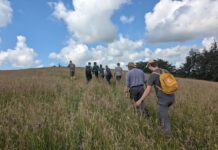Dr Rachael Benstead, senior aquatic ecotoxicologist at translational science and research organisation Fera Science, explains why she believes testing in a realistic environment could change the way we understand the environmental impact of neonicotinoid pesticides.

As of September 1, 2018, the use of five neonicotinoid pesticides are banned in France, making the nation stricter than the European Union, which has only banned three of the five popular pesticides. The move comes after various studies demonstrated the potential harmful impact of the nicotine-based chemicals on bees and aquatic invertebrates.
As well as the total ban in France, Canada has given farmers three years to find alternatives to two of the three nicotine-based pesticides currently approved for use across the nation. Health Canada’s Pest Management Regulation Agency (PMRA) wants to phase out the outdoor use of thiamethoxam and clothianidin.
Background to the Canada ban
The PMRA began studying the pesticides in 2012 in response to concerns about the impact on honey bees. However, it was the results of a subsequent study in 2016 that highlighted the potential impact on aquatic invertebrates and led to the decision to ban the products.
Similar, limited studies in laboratory and confined mesocosm* testing facilities by the US Environmental Protection Agency (EPA) found that aquatic insects are highly sensitive to neonicotinoids and the impact on aquatic invertebrates can have cascading effects on food webs and healthy ecosystem function. This includes low level, sublethal exposures resulting in decreases in species abundance and altered predator-prey relationships.
The EPA also states that current federal aquatic life benchmarks for neonicotinoids are potentially underestimating risks. Unusual chemical mixtures and their potential synergistic effects are not being considered in aquatic risk assessments, resulting in unknown risks to species.
This not only raises questions about the process of bringing plant protection products (PPPs) to market, but also around the trustworthiness of studies that purport to assess the level of risk neonicotinoids pose to aquatic ecosystems.
Higher-tier testing in an environment that more closely replicates edge-of-field waterbodies holds the potential to change that in the future. The first fully flow-through field scale mesocosm exposure facility in Europe, the Edge of Field Waterbody Safety Assessment Facility (E-Flows), located at Fera’s base in Yorkshire, will be better able to support organisms with the resources needed to establish larger populations and ensure safer testing of agrochemicals. It is managed and operated by Fera in partnership with the group Crop Health And Protection (CHAP).
A realistic environment
The E-flows mesocosm provides a test-bed of 60 realistic streams, each having a continuous supply of aged fresh water, consisting of around 400 cubic meters per day. This facility offers a realistic, but closely controlled, edge-of-field surface that exposes plant protection products in a more realistic scenario than more traditional styles of study environments.
Using advanced testing facilities, which can provide new scientific data, will help us to understand environmental impacts and the potential risks of neonicotinoid-containing pesticides to aquatic organisms in a way never possible before.
Alternative pesticides
The pesticides in question here are extremely popular, meaning the proposed bans have left farmers concerned about sourcing alternatives — as well as raising questions about whether existing alternatives are any better for the environment. For example, many must be applied in much higher doses in order to be effective.
The impact of pesticides on the wider environment and public health remains unclear. This, in addition to the recent view of organisations like the EPA that their potential risks are being underestimated, makes it clear that product testing phases must generate broader datasets about environmental interactions.
While traditional methods of testing still yield enough data for some chemical products to be tested and approved by regulatory bodies, some of their potential risks may not be fully evaluated. The progress being made, particularly with facilities such as the E-flows mesocosm, will support the development of novel crop protection products while helping mitigate risks and provide more choice across the farming industry.
As the E-Flows mesocosm provides a realistic test bed and is stocked with a variety of plants and invertebrates, the data produced is a more accurate view of how crop protection chemicals will interact with nearby aquatic ecosystems. This provides a tool that will generate exposure scenarios and effects data and pushes the science beyond the capabilities of existing technology.
Of course, this also provides an interesting commercial opportunity for manufacturers of crop protection chemicals. By providing the market with new products supported by data of this high quality, pesticide and biocide manufacturers will be in a position to fill the gap left by the removal of neonicotinoids from agriculture.
* The term mesocosm refers to any outdoor experimental system that examines the natural environment under controlled conditions. In this way mesocosm studies provide a link between field surveys and highly controlled laboratory experiments.








